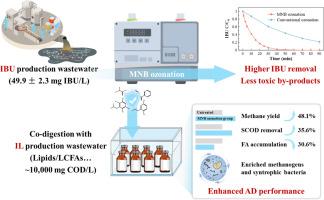Micro-nano bubble ozonation for effective treatment of ibuprofen-laden wastewater and enhanced anaerobic digestion performance
IF 12.4
1区 环境科学与生态学
Q1 ENGINEERING, ENVIRONMENTAL
引用次数: 0
Abstract
The pharmaceutical industry plays a crucial role in driving global economic growth but also poses substantial environmental challenges, particularly in the efficient treatment of production wastewater. This study investigates the efficacy of micro-nano bubble (MNB) ozonation for treating high-strength ibuprofen (IBU)-laden wastewater (49.9 ± 2.3 mg/L) and mitigating its inhibitory effects on the anaerobic digestion (AD) of intralipid (IL)-laden wastewater. Our findings demonstrated that MNB ozonation achieved a 99.0 % removal efficiency of IBU within 70 min, significantly surpassing the 69.8 % efficiency observed with conventional ozonation under optimal conditions. Both conventional and MNB ozonation primarily transformed IBU through oxidation processes, including hydroxylation and the conversion of C![]() H bonds to C = O groups, along with carbon cleavage. However, MNB ozonation markedly reduced the toxicity of IBU-laden wastewater by further transforming toxic by-products, particularly under mildly alkaline conditions (pH 7.2 and 9.0). This reduction in toxicity led to a significant improvement in subsequent AD performance; specifically, a 70-min MNB ozonation pretreatment enhanced methane production by 48.1 %, increased chemical oxygen demand removal by 35.6 %, and reduced fatty acid accumulation compared to the control without pretreatment. Additionally, the effluent from MNB ozonation positively impacted the microbial community, particularly by enriching syntrophic bacteria and methanogens. Overall, these findings offered new insights into the behavior and toxicity of IBU oxidation by-products in both conventional and MNB ozonation processes. Furthermore, this study proposed a novel strategy for the combined treatment of IBU- and IL-laden wastewaters, establishing a robust foundation for advancing MNB ozonation technology in engineered pharmaceutical wastewater treatment.
H bonds to C = O groups, along with carbon cleavage. However, MNB ozonation markedly reduced the toxicity of IBU-laden wastewater by further transforming toxic by-products, particularly under mildly alkaline conditions (pH 7.2 and 9.0). This reduction in toxicity led to a significant improvement in subsequent AD performance; specifically, a 70-min MNB ozonation pretreatment enhanced methane production by 48.1 %, increased chemical oxygen demand removal by 35.6 %, and reduced fatty acid accumulation compared to the control without pretreatment. Additionally, the effluent from MNB ozonation positively impacted the microbial community, particularly by enriching syntrophic bacteria and methanogens. Overall, these findings offered new insights into the behavior and toxicity of IBU oxidation by-products in both conventional and MNB ozonation processes. Furthermore, this study proposed a novel strategy for the combined treatment of IBU- and IL-laden wastewaters, establishing a robust foundation for advancing MNB ozonation technology in engineered pharmaceutical wastewater treatment.


微纳气泡臭氧化有效处理含布洛芬废水并提高厌氧消化性能
制药业在推动全球经济增长方面发挥着至关重要的作用,但也带来了巨大的环境挑战,特别是在生产废水的有效处理方面。研究了微纳泡(MNB)臭氧氧化处理高浓度布洛芬(IBU)废水(49.9±2.3 mg/L)的效果,并减轻了其对含脂内酯(IL)废水厌氧消化(AD)的抑制作用。结果表明,在最优条件下,MNB臭氧化在70 min内对IBU的去除率达到99.0%,显著高于常规臭氧化的69.8%。常规臭氧化和MNB臭氧化主要通过氧化过程转化IBU,包括羟基化和C- h键转化为C=O基团,以及碳裂解。然而,MNB臭氧化通过进一步转化有毒副产物,显著降低了含ibu废水的毒性,特别是在轻度碱性条件下(pH 7.2和9.0)。这种毒性的降低导致了随后AD性能的显著改善;具体而言,与未进行预处理的对照组相比,70分钟的MNB臭氧化预处理使甲烷产量提高48.1%,化学需氧量去除率提高35.6%,脂肪酸积累减少。此外,MNB臭氧化出水对微生物群落产生了积极影响,特别是通过丰富合养细菌和产甲烷菌。总的来说,这些发现为传统和MNB臭氧化过程中IBU氧化副产物的行为和毒性提供了新的见解。此外,本研究提出了IBU-和il -负载废水联合处理的新策略,为推进MNB臭氧化技术在工程制药废水处理中的应用奠定了坚实的基础。
本文章由计算机程序翻译,如有差异,请以英文原文为准。
求助全文
约1分钟内获得全文
求助全文
来源期刊

Water Research
环境科学-工程:环境
CiteScore
20.80
自引率
9.40%
发文量
1307
审稿时长
38 days
期刊介绍:
Water Research, along with its open access companion journal Water Research X, serves as a platform for publishing original research papers covering various aspects of the science and technology related to the anthropogenic water cycle, water quality, and its management worldwide. The audience targeted by the journal comprises biologists, chemical engineers, chemists, civil engineers, environmental engineers, limnologists, and microbiologists. The scope of the journal include:
•Treatment processes for water and wastewaters (municipal, agricultural, industrial, and on-site treatment), including resource recovery and residuals management;
•Urban hydrology including sewer systems, stormwater management, and green infrastructure;
•Drinking water treatment and distribution;
•Potable and non-potable water reuse;
•Sanitation, public health, and risk assessment;
•Anaerobic digestion, solid and hazardous waste management, including source characterization and the effects and control of leachates and gaseous emissions;
•Contaminants (chemical, microbial, anthropogenic particles such as nanoparticles or microplastics) and related water quality sensing, monitoring, fate, and assessment;
•Anthropogenic impacts on inland, tidal, coastal and urban waters, focusing on surface and ground waters, and point and non-point sources of pollution;
•Environmental restoration, linked to surface water, groundwater and groundwater remediation;
•Analysis of the interfaces between sediments and water, and between water and atmosphere, focusing specifically on anthropogenic impacts;
•Mathematical modelling, systems analysis, machine learning, and beneficial use of big data related to the anthropogenic water cycle;
•Socio-economic, policy, and regulations studies.
 求助内容:
求助内容: 应助结果提醒方式:
应助结果提醒方式:


